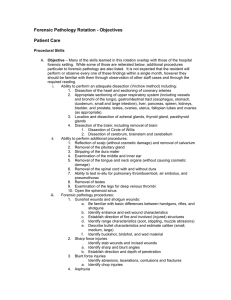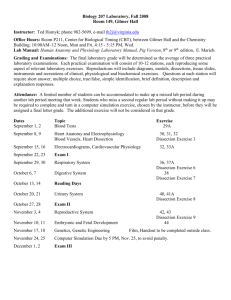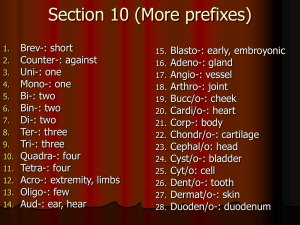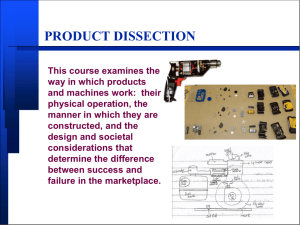Autopsy - Objectives Patient Care Procedural Skills
advertisement
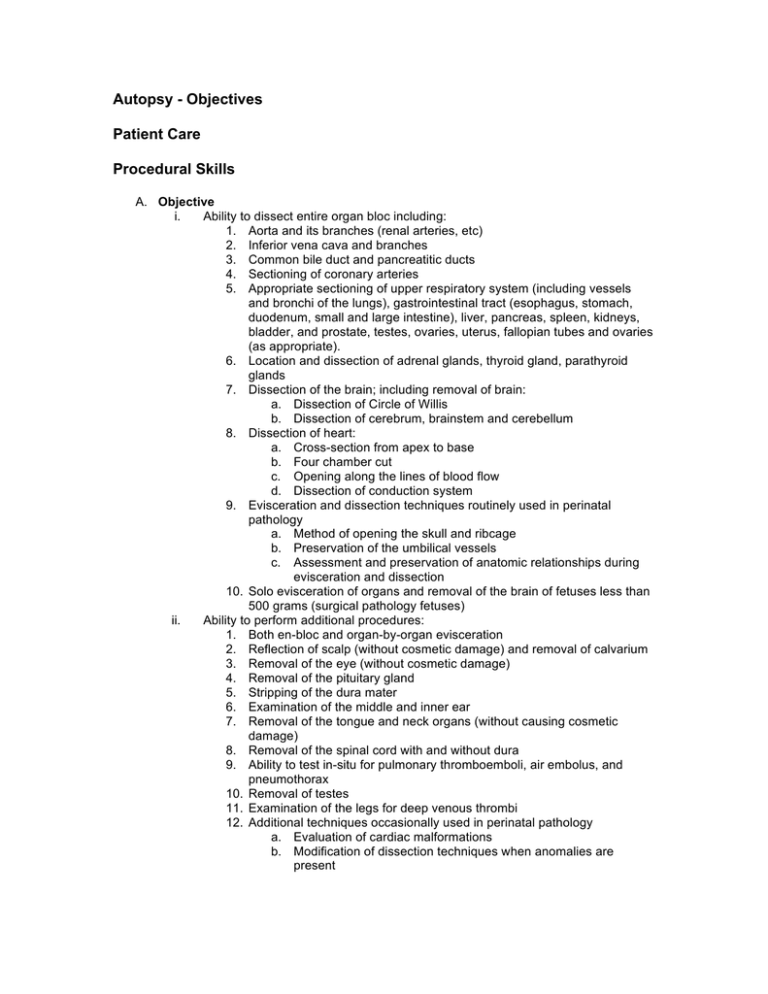
Autopsy - Objectives Patient Care Procedural Skills A. Objective i. Ability to dissect entire organ bloc including: 1. Aorta and its branches (renal arteries, etc) 2. Inferior vena cava and branches 3. Common bile duct and pancreatitic ducts 4. Sectioning of coronary arteries 5. Appropriate sectioning of upper respiratory system (including vessels and bronchi of the lungs), gastrointestinal tract (esophagus, stomach, duodenum, small and large intestine), liver, pancreas, spleen, kidneys, bladder, and prostate, testes, ovaries, uterus, fallopian tubes and ovaries (as appropriate). 6. Location and dissection of adrenal glands, thyroid gland, parathyroid glands 7. Dissection of the brain; including removal of brain: a. Dissection of Circle of Willis b. Dissection of cerebrum, brainstem and cerebellum 8. Dissection of heart: a. Cross-section from apex to base b. Four chamber cut c. Opening along the lines of blood flow d. Dissection of conduction system 9. Evisceration and dissection techniques routinely used in perinatal pathology a. Method of opening the skull and ribcage b. Preservation of the umbilical vessels c. Assessment and preservation of anatomic relationships during evisceration and dissection 10. Solo evisceration of organs and removal of the brain of fetuses less than 500 grams (surgical pathology fetuses) ii. Ability to perform additional procedures: 1. Both en-bloc and organ-by-organ evisceration 2. Reflection of scalp (without cosmetic damage) and removal of calvarium 3. Removal of the eye (without cosmetic damage) 4. Removal of the pituitary gland 5. Stripping of the dura mater 6. Examination of the middle and inner ear 7. Removal of the tongue and neck organs (without causing cosmetic damage) 8. Removal of the spinal cord with and without dura 9. Ability to test in-situ for pulmonary thromboemboli, air embolus, and pneumothorax 10. Removal of testes 11. Examination of the legs for deep venous thrombi 12. Additional techniques occasionally used in perinatal pathology a. Evaluation of cardiac malformations b. Modification of dissection techniques when anomalies are present iii. Note: Residents on their first rotation are required to perform the procedures listed in (i.) and those on their second rotation to perform the procedures listed in (i. and ii.). iii. iv. v. vi. Submit appropriately fixed and trimmed blocks for histologic studies Appropriately document pathologic findings photographically Apply infectious disease precautions during the performance of an autopsy Anticipate and arrange for ancillary studies (microbiological cultures, cytogenetics, DNA analysis, toxicology, electron microscopy) B. Plan iii. Procedural skills will be taught by attending pathologists; and experienced residents on their second rotation iv. Of the procedures listed under 1.a.ii above, one must be witnessed by an attending pathologist. Each resident must maintain a log of the above procedures, and have the procedure initialed once it is witnessed C. Assessment . The procedures are taught by the attending pathologists and experienced residents; the procedures are supervised by the attending pathologists and experienced residents; and documentation of completion of procedures in 1.a.ii is maintained by the individual resident and witnessed by the attending pathologist. Interpretive skills A. Objective i. Ability to interpret, present, and summarize (in writing) a medical record ii. Competently perform an external, internal and microscopic examination (with interpretation of gross and microscopic pathologic changes) B. Plan i. Interpretative skills are taught by the attending pathologists and experienced residents C. Assessment i. Interpretative skills will be assessed by attending pathologist informally through editing/correcting of resident’s autopsy reports which have been turned in for review prior to finalization
